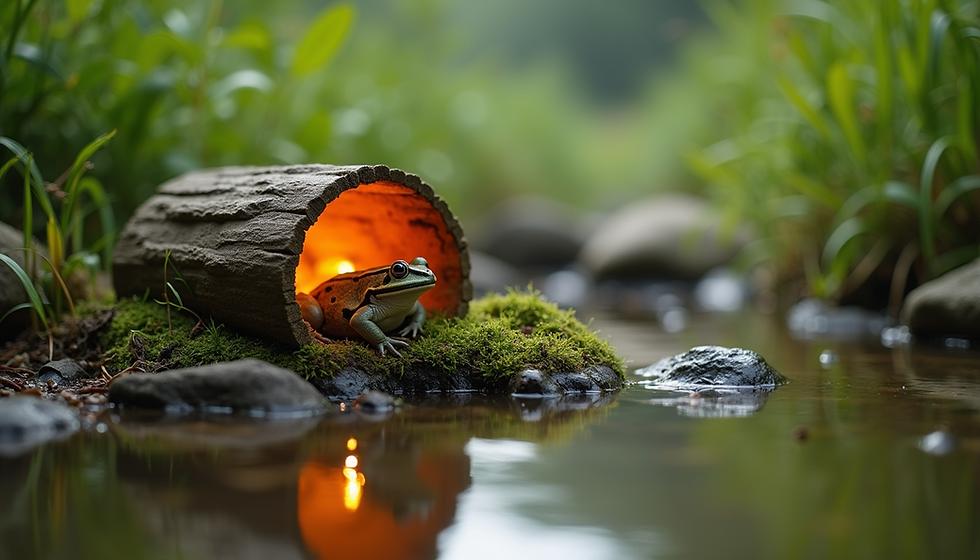Creating the Perfect Bioactive Enclosure for Your Pets
- Joel Scoby

- Oct 17
- 4 min read
Creating a bioactive enclosure for your pets can transform their living environment into a miniature version of the wild. This type of habitat not only looks beautiful but also replicates the natural ecosystem, making it healthy for your pets. Imagine your reptiles basking under a bright light while ferns grow lush around them. In this guide, we'll explore how to build this thriving ecosystem, ensuring your pets enjoy a safe and stimulating space.

Understanding Bioactive Enclosures
Bioactive enclosures replicate the natural environments of the pets they house. They integrate live plants, beneficial microorganisms, and various substrates to create a balanced ecosystem. The main goal is to create a self-cleaning environment that minimizes maintenance while promoting your pets' well-being.
This setup can benefit a range of pets, including reptiles, amphibians, and small mammals. For example, a leopard gecko enclosure can include live plants that maintain humidity while providing cover. By understanding your pet’s needs, you can customize their habitat effectively.
Choosing the Right Container
The first step in creating a bioactive enclosure is selecting an appropriate container. The size and type will depend on your pet species. For instance, glass terrariums are excellent for reptiles and amphibians, while larger wooden enclosures work well for small mammals.
When choosing a container, ensure to consider:
Size: Make sure the enclosure is spacious enough. For example, a bearded dragon should have at least a 40-gallon tank to roam freely.
Ventilation: Proper airflow is essential for managing humidity and preventing mold growth. Look for containers that have adjustable ventilation holes.
Accessibility: Choose a container that allows for easy access for feeding and cleaning. An enclosure with a front-opening door can simplify this process.
Creating the Substrate Layer
The substrate is the foundation of your bioactive enclosure and plays a critical role in maintaining a healthy ecosystem. A good substrate should facilitate drainage, support plant growth, and allow beneficial microorganisms to thrive.
Consider a substrate mix like this:
Drainage Layer: Start with materials like hydroton or gravel. This layer should be about 2-3 inches thick to prevent water from pooling. This is crucial; excess water can lead to root rot.
Soil Layer: Add a 3-4 inch nutrient-rich soil mix suitable for your plants. Ensure the soil is organic and free from chemicals to protect your pets.
Top Layer: Lastly, include a 1-2 inch layer of leaf litter or organic mulch. This not only provides a natural look but also retains moisture and creates a habitat for microfauna.

Lush green ferns with intricate patterns fill the image, creating a serene and natural atmosphere. Dark background enhances depth.
Selecting Plants for Your Enclosure
Plants are vital in a bioactive enclosure as they offer shelter, food, and oxygen. When selecting plants, choose species that are non-toxic and fit the enclosure's conditions—like humidity and light levels.
Some ideal plant choices include:
Ferns: Perfect for humid environments, ferns like the Boston fern provide excellent cover.
Moss: Moss retains moisture well and enhances the natural appearance of the enclosure.
Pothos: This resilient plant is easy to maintain and adapts to various conditions, making it ideal for busy pet owners.
Spider Plant: Known for purifying air, spider plants are also safe for pets and thrive indoors.
Introducing Microfauna
Microfauna, such as springtails and isopods, are essential for a balanced bioactive enclosure. These tiny organisms break down waste and aerate the substrate. This not only helps maintain a clean environment but also creates soil suitable for plant growth.
To introduce microfauna:
Purchase from a Reputable Source: Get healthy microfauna from a trusted supplier to ensure they help establish your ecosystem.
Acclimate Them: Gradually introduce them to the new environment. This might take a few hours to ensure they adjust to temperature and humidity.
Monitor Their Population: Regularly check on your microfauna. A healthy population reduces mold and keeps the environment tidy.
Setting Up the Environment
After you have your substrate, plants, and microfauna, it’s time for the final touches. This includes adding decorations, hiding spots, and ensuring proper temperature and humidity levels.
Consider these elements:
Hiding Spots: Use rocks, logs, or commercially available hides to provide shelter. For example, hollow logs can create cozy retreats for your pets.
Water Source: Incorporate a shallow water dish or a small water feature. This not only hydrates your pets but also helps maintain humidity.
Lighting: Use appropriate lighting. For instance, UVB lighting is vital for many reptiles, and LED grow lights can promote plant health.
Ongoing Care and Support
Creating a bioactive enclosure requires ongoing care. Regular monitoring ensures a thriving habitat. Keep an eye on the following aspects to maintain a balanced ecosystem:
Watering: Check the moisture of the substrate regularly. Plants may need watering once a week, but be careful not to overwater. Aim for slightly damp soil.
Cleaning: Even though bioactive enclosures are low-maintenance, you should still remove uneaten food or waste every few days.
Plant Care: Regularly evaluate your plants. Prune overgrown sections and replace any struggling plants to ensure a vibrant appearance.
A Rewarding Journey Awaits
Building a bioactive enclosure is a fulfilling project that can greatly enhance the quality of life for your pets. By carefully selecting the right container, substrate, plants, and microfauna, you can create a thriving ecosystem that mirrors their natural habitat.
Remember, regular monitoring and maintenance will ensure your enclosure is both beautiful and beneficial. Enjoy the unique experience of crafting an environment where your pets can thrive, and embrace the journey of creating a self-sustaining habitat.




Comments